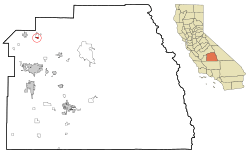Cutler, California facts for kids
Quick facts for kids
Cutler, California
|
|
|---|---|

Location in Tulare County and the state of California
|
|
| Country | |
| State | |
| County | Tulare |
| Area | |
| • Total | 1.22 sq mi (3.17 km2) |
| • Land | 1.22 sq mi (3.17 km2) |
| • Water | 0.00 sq mi (0.00 km2) 0% |
| Elevation | 361 ft (110 m) |
| Population
(2020)
|
|
| • Total | 4,480 |
| • Density | 3,660.13/sq mi (1,413.71/km2) |
| Time zone | UTC-8 (Pacific (PST)) |
| • Summer (DST) | UTC-7 (PDT) |
| ZIP code |
93615
|
| Area code(s) | 559 |
| FIPS code | 06-17708 |
| GNIS feature ID | 1658363 |
Cutler is a small community in Tulare County, California, United States. It is known as a "census-designated place" (CDP). This means it's a recognized area by the government for counting people, but it's not an officially incorporated city. In 2010, about 5,000 people lived in Cutler. By 2020, the population was 4,480.
Geography of Cutler
Cutler is located in central California at 36°31′29″N 119°17′20″W / 36.52472°N 119.28889°W. It covers about 0.8 square miles (2.1 square kilometers) of land. The community is found where two roads, routes 63 and 201, meet. Cutler is also close to the bottom of the Sierra Nevada Mountain Foothills.
History of Cutler
Cutler's history is closely tied to the railroad. In 1897, train tracks reached the town. The San Francisco and San Joaquin Valley Railroad built a station and offered rides for people and goods. Cutler was an important stop on the Visalia District line.
In 1899, this railroad became part of the Santa Fe Railroad. Later, in 1914, another rail line was added just east of town. Cutler remained a key rail junction until the 1970s. However, as fewer goods were shipped by train, the Santa Fe Railroad sold the lines in 1992. Soon after, the tracks were taken up.
People of Cutler
Cutler has seen changes in its population over the years. In 2000, there were 4,491 people living here. By 2010, the population grew to 5,000. The most recent count in 2020 showed 4,480 residents.
The community of Cutler is very diverse. Over the last 50 years, many immigrants from Mexico have moved to the area. Because of this, Cutler has become a community where most people are of Hispanic background. Many families came from places like Michoacan, Zacatecas, and Nuevo Leon in Mexico.
Filipinos have also become an important part of Cutler's culture. They have brought their rich traditions, including their languages like Ilocano and Tagalog. They also introduced delicious foods such as Lumpia, Adobo, and Lechon. This mix of cultures makes Cutler a unique and vibrant place.
See also
 In Spanish: Cutler (California) para niños
In Spanish: Cutler (California) para niños


